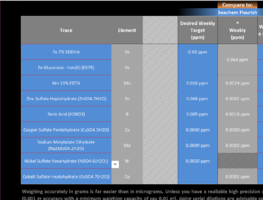Hi Folks,
I'm trying to determine if two trace elements - cobalt and nickel - are required in planted aquaria. Neither of these elements are listed in the index of Ecology of the Planted Aquarium*. Referring to James' Planted Tank**, I see that cobalt is present in both Seachem Flourish and Seachem Flourish Trace. And nickel is only present in the latter of these two nutrients. Other current fertilizers, e.g. TNC Complete and APT Complete do not appear to include either cobalt or nickel. OK, so why am I asking about this? It's simply because both these elements are required by cyanobacteria (aka BGA). I am fully aware that other factors play a part in the growth of cyano, e.g. dissolved organic matter (DOM) but why add cobalt and/or nickel to our tanks if it could potentially cause problems?
For anyone using urea in their tanks, the enzyme urease contains nickel.
Caveat: I am by no means an expert in the topic that I am introducing here. I am simply trying to get a more complete understanding of the factors that may contribute to cyanobacteria in freshwater aquaria. And if fertilizers play any part in this, that's why I've placed this thread under "Aquarium Fert Dosing".
* by Diana Walstad
** James' Planted Tank - Comparison Of Traces
JPC
I'm trying to determine if two trace elements - cobalt and nickel - are required in planted aquaria. Neither of these elements are listed in the index of Ecology of the Planted Aquarium*. Referring to James' Planted Tank**, I see that cobalt is present in both Seachem Flourish and Seachem Flourish Trace. And nickel is only present in the latter of these two nutrients. Other current fertilizers, e.g. TNC Complete and APT Complete do not appear to include either cobalt or nickel. OK, so why am I asking about this? It's simply because both these elements are required by cyanobacteria (aka BGA). I am fully aware that other factors play a part in the growth of cyano, e.g. dissolved organic matter (DOM) but why add cobalt and/or nickel to our tanks if it could potentially cause problems?
For anyone using urea in their tanks, the enzyme urease contains nickel.
Caveat: I am by no means an expert in the topic that I am introducing here. I am simply trying to get a more complete understanding of the factors that may contribute to cyanobacteria in freshwater aquaria. And if fertilizers play any part in this, that's why I've placed this thread under "Aquarium Fert Dosing".
* by Diana Walstad
** James' Planted Tank - Comparison Of Traces
JPC





